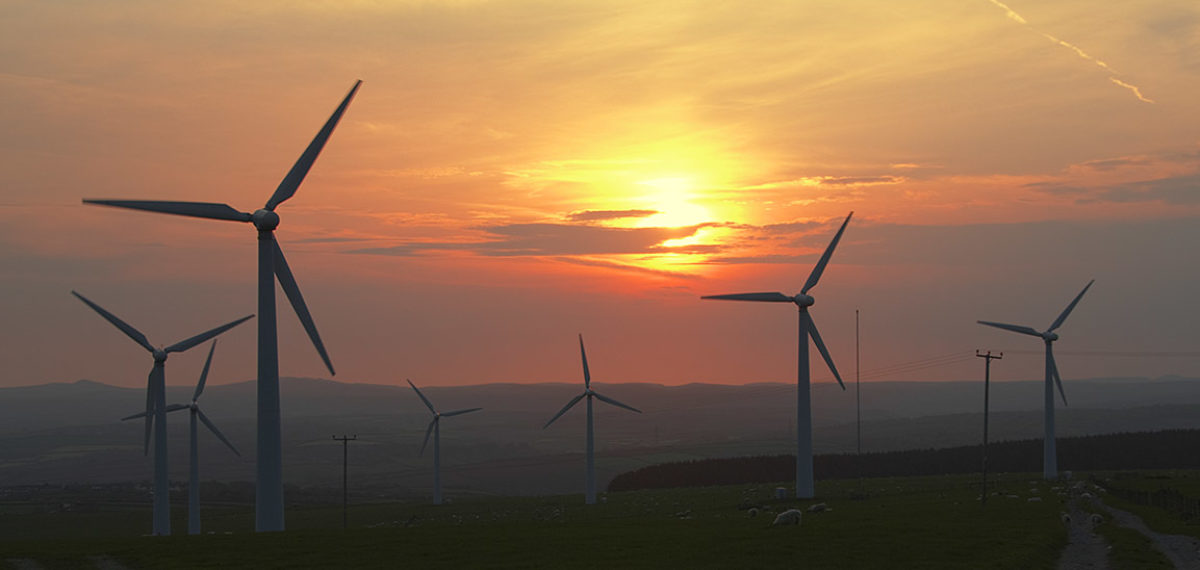How we can supply all UK energy needs from renewables
by David Toke
A recent report from the International Energy Agency [1] has demonstrated how offshore wind power alone can supply 18 times more energy than the current world supply of electricity, including 16 times the electricity supply of Europe – with the UK better placed than any country to marshall this resource. The need to supply ALL UK energy (not just electricity) by 2050 (or sooner) under the ‘net zero carbon’ target could increase UK electricity production between approximately 2.5-4 times (see later section on this). But this appears to be easily obtainable from offshore wind resources alone – and of course there’s plenty of solar power and other renewable energy sources to add to this potential. Of course supplying less rather than more renewable energy to meet the 100 per cent target is preferable – hence the need to choose the most energy efficient systems!
Renewable energy is cheaper than other options
The cost of renewable energy has been hurtling downwards. Around the world solar pv and wind power are now the cheapest widely available sources of electricity. For example, last Autumn the UK Government auctioned off some contracts to supply electricity from some big proposed offshore windfarms, and the prices came in at £40 per MWh (2012 prices)[2] – that’s less than half the cost of power from Hinkley C nuclear power station (£92.50 per MWh) and also less than what it would cost to build a large scale gas fired power station. Although developers have stopped building big fossil fuel power plant (despite getting incentives to provide ‘capacity’) onshore wind and solar pv farms are being built without any subsidies .
Making so-called ‘blue hydrogen’ from natural gas (through carbon capture and storage, CCS) is sometimes suggested as a cheap means of decarbonisation – but in reality this is very expensive if it is used to remove close to 100 per cent of the carbon[3].
Renewable energy can guarantee firm power
Intra-day variability of renewable energy can be managed through use of batteries, the cost of which has continued to decline, and whose capacity is rapidly expanding. Batteries in electric vehicles can be used as an effective electricity store, and the battery capacity in EVs will be very large compared to UK electricity requirements as the number of EVs increases.
Inter-seasonal storage of energy from renewable can also be cheaply stored by converting renewable energy, when it is excess to requirements (and thus zero or next to zero in cost), into energy carriers such as compressed air or ammonia (and other possibilities, eg hydrogen stored in caverns, water balloons next to offshore windfarms, liquid electrolyte from flow batteries). Many days worth of UK renewable electricity supply can be stored for long periods using such means and then used to generate electricity when needed by using in converted gas engines, gas turbines or fuel cells. Siemens has already piloted a relevant system using ammonia[4].
How much energy do we need?
According to a study done by Imperial College (commissioned by the Committee on Climate Change) the UK economy would need (for most purposes) around 700 TWh of electricity if electricity was mostly used to supply UK energy demand[5]. Heat pumps (powered by electricity) , which feature prominently in such models, will use electricity several times more efficiently than hydrogen substituted for natural gas. Electric vehicles will also use renewable energy much more efficiently compared to hydrogen powered vehicles.
Added to this some ‘niche’ uses of hydrogen (converted from renewable electricity through electrolysis) may include long term storage (through ammonia production), industry and HGVs and bring UK energy demand up to about 800 TWh a year. If hydrogen, from renewable energy, was used to substitute for natural gas for around half of current gas heating (rather than use heat pumps) then energy demand be more like around 1050 TWh, or 1300 TWh if all heating was supplied by hydrogen [6]. This compares to UK electricity generation in 2018 of 333 TWh[7]. This difference illustrates the need to have energy efficient buildings powered as much as possible by heat pumps!
As can be seen on our wind page, offshore wind could easily supply these amounts from from the seas surrounding Britain, although that does not mean that it will supply everything! Onshore wind, solar pv, biogas and wave and tidal technologies can supply lots as well. The amounts from the different technologies depend on the markets and competition, but of course also how those markets are structured through the regulatory system – and of course on what sort of help we give different technologies to enable them to develop their potential.
References:
[1] International Energy Agency (2019) Global Offshore Wind Outlook, https://webstore.iea.org/download/direct/2886?fileName=Offshore_Wind_Outlook_2019.pdf
[2] Gov. UK (2019) Contracts for Difference Allocations Round 3 https://www.gov.uk/government/publications/contracts-for-difference-cfd-allocation-round-3-results
[3] Friends of the Earth (2019) Faster, Deeper and Fairer Carbon Pollution Cuts Needed, page 5, https://policy.friendsoftheearth.uk/insight/faster-deeper-and-fairer-carbon-pollution-cuts-needed
[4] Siemens (2018) ‘Green Ammonia is the key to meeting the twin challenges of the 21st century’ https://new.siemens.com/uk/en/company/topic-areas/sustainable-energy/green-ammonia.html
[5] Imperial College, London (2018) Analysis of Alternative UK Heat Decarbonisation Paths, Committee on Climate Change, Figure 2-19, page 78), https://www.theccc.org.uk/publication/analysis-of-alternative-uk-heat-decarbonisation-pathways/
[6] Hydrogen requirements in this paragraph calculated from ‘niche hydrogen’ scenario and also buildings heating element in ‘Full hydrogen’ scenario from Hydrogen in a Low Carbon Economy, (2018), Committee on Climate Change, Figure 4.1 page 97, https://www.theccc.org.uk/publication/hydrogen-in-a-low-carbon-economy/
[7] Gov.UK, Electricity generation and supply figures for Scotland, Wales, Northern Ireland and England, 2015 to 2018 https://assets.publishing.service.gov.uk/government/uploads/system/uploads/attachment_data/file/853549/Regional_Electricity_Generation_and_Supply_2015_to_2018.pdf
